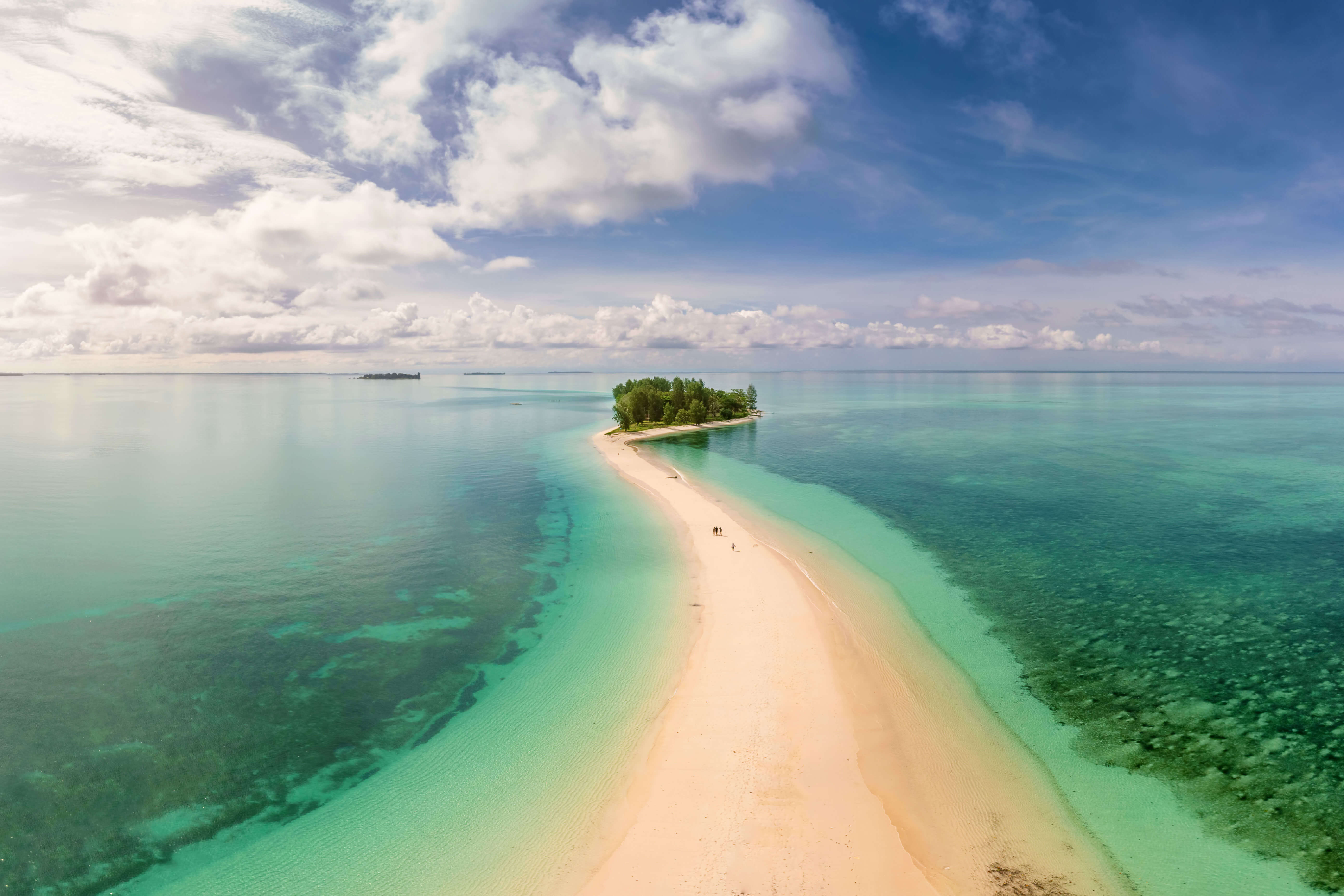1/1 Oops. Incorrect.
0%
0pts Earned
0/1correct
21/21
The deepest trench in the Atlantic is named for which Caribbean island?
The Puerto Rico Trench is the deepest part of the Atlantic Ocean, reaching more than 27,000 feet beneath the water’s surface. Located just north of Puerto Rico and the Virgin Islands, the trench marks the boundary between two tectonic plates and separates the Atlantic Ocean from the Caribbean Sea. The deepest point of the trench is called the Milwaukee Depth, named for the USS Milwaukee, the naval cruiser that first measured it.
Source: NOAACuba
8%
Antigua
36%
Puerto Rico
42%
Aruba
13%
20/21
What is the largest waterfall system in the world by number of falls?
Legend has it that when former U.S. First Lady Eleanor Roosevelt first saw Iguazu Falls, she remarked, “My poor Niagara!” Whether or not she actually said it, it’s true that the waterfall system on the Argentina-Brazil border dwarfs Niagara Falls. With an incredible 275 individual cascades, it is the largest waterfall system in the world.
Source: Travel AwaitsGullfoss Falls
6%
Niagara Falls
20%
Iguazu Falls
62%
Kuang Si Falls
11%
19/21
What is the world's longest lake?
Located in the Great Rift Valley of East Africa, Lake Tanganyika stretches for more than 420 miles and divides four countries — Tanzania, the Democratic Republic of the Congo, Burundi, and Zambia. At 12,700 square miles in total size, Lake Tanganyika the second-largest freshwater lake in the world, after Russia’s Lake Baikal.
Source: Live ScienceLake Titicaca
38%
Lake Ontario
10%
Lake Tahoe
4%
Lake Tanganyika
48%
18/21
Where is the saltiest body of water on Earth?
If you thought the Great Salt Lake was salty, then you’ve never floated in Gaet’ale Pond in Ethiopia. While the average percentage of salt by weight is 3.38% in the world’s oceans, this small body of water measures a whopping 43.3%. In contrast, the Great Salt Lake’s saline content varies from 5% to 27%, while the Dead Sea, another famously salty body of water, measures 34%.
Source: Guinness World RecordsAntarctica
8%
Utah
36%
Ethiopia
17%
Israel
39%
17/21
What is the world’s largest tropical wetland area?
The Pantanal region covers more than 70,000 square miles in three countries — Brazil, Bolivia, and Paraguay — and contains both national park land and areas protected as UNESCO World Heritage Sites. Saturated with torrential rains, the Patanal's enormous basin fills every year, draining slowly into the Paraguay River. The region has the highest concentration of wildlife in South America.
Source: National GeographicThe Camargue, France
1%
The Mekong Delta, Vietnam
31%
The Pantanal, Brazil
32%
The Everglades, United States
35%
16/21
What river flows into the world's largest waterfall?
Also known as “Mosi-oa-Tunya” (meaning “The Smoke That Thunders”), Victoria Falls is the largest curtain of falling water in the world. It’s situated about midway through the course of the Zambezi River and marks the boundary between Zambia to the north and Zimbabwe to the south. The Zambezi River stretches for 1,599 miles, making it Africa’s fourth-longest river.
Source: UNESCOZambezi River
54%
St. Lawrence River
13%
Amazon River
23%
Yangtze River
9%
15/21
Where can you find the deepest freshwater lake in the world?
If you wanted to get to the bottom of Siberia’s Lake Baikal, you'd have to dive an astonishing 5,354 feet. In addition to being the deepest freshwater lake, it is also the planet’s oldest and biggest lake by volume, with as many as 1,800 endemic species of animals and plants that call it home.
Source: Live ScienceMichigan, USA
16%
Siberia, Russia
68%
Malawi
3%
Ottawa, Canada
13%
14/21
The Bosphorus Strait connects which two bodies of water?
Istanbul, Turkey, is divided by the Bosphorus Strait, which also connects two important seas — the Black Sea to the north and the Sea of Marmara to the south. The Sea of Marmara leads to the Mediterranean Sea via the Dardanelles Strait and the Aegean Sea, and because of this the Bosphorus has long been one of the world’s most strategically important maritime trade routes.
Source: Afar MagazineBlack Sea and Sea of Marmara
43%
Arabian Sea and Red Sea
26%
Black Sea and Dead Sea
21%
Yellow Sea and Pacific Ocean
10%
13/21
What is the world's largest bay?
At more than 830,000 square miles, the Bay of Bengal in the northeastern Indian Ocean is larger than even the Gulf of Mexico. The Bay of Bengal measures roughly 1,000 miles wide, and it borders the countries of Sri Lanka, India, Bangladesh, and Burma. But while the Bay of Bengal is large, it's relatively shallow.
Source: National GeographicBay of Bengal
53%
Chesapeake Bay
11%
Tokyo Bay
9%
Hudson Bay
26%
12/21
In which U.S. national park can you find the Grand Prismatic Spring?
The Grand Prismatic Spring at Yellowstone National Park in Wyoming is a sight to behold, thanks to the literal prism of colors it emits. This powerful hot spring is deeper than a 10-story building and notable for the bright bands of orange, yellow, green, and blue that form around its edge.
Source: Outside MagazineZion
10%
Rocky Mountain
3%
Yosemite
19%
Yellowstone
68%
11/21
Which country has the most reported lakes in the world?
Of the approximately 1.42 million lakes around the world, Canada is home to 62% of them. There are 879,800 lakes in Canada, according to a 2016 study published in Nature Communications. (The study only accounted for lakes greater than 0.1 square kilometers in size.) Russia is next with 201,200 lakes, followed by the U.S. with 102,500 lakes.
Source: World AtlasKenya
2%
Mexico
1%
Finland
22%
Canada
74%
10/21
What is the Earth’s largest inland body of water?
Located at the junction of Europe and Asia — touching Russia, Azerbaijan, Turkmenistan and Kazakhstan — the Caspian Sea has a surface area of 143,244 square miles. Despite its name, the Caspian Sea can be considered either a lake or a sea. While it has the size and salt content of a sea, it is entirely enclosed by land and embodies many of the characteristics of a lake.
Source: Live ScienceLake Michigan
26%
Crater Lake
13%
Caspian Sea
52%
Aral Sea
8%
9/21
The "Coral Triangle" is located in which of the world’s oceans?
Much less ominous than the Bermuda Triangle, the Coral Triangle is located in the western Pacific Ocean and includes the waters of Indonesia, Malaysia, the Philippines, Timor Leste, Papua New Guinea, and the Solomon Islands. The region is named for the huge numbers of coral that call it home, including nearly 600 species of reef-building corals, or 75% of the world’s coral species.
Source: World Wildlife FundIndian
29%
Atlantic
15%
Southern
15%
Pacific
41%
8/21
The bulk of the Amazon River runs through which country?
The Amazon is the world’s second-largest river, flowing through nine countries in South America. While there has been some historical speculation about its actual source, the most widely accepted theory is that the Amazon begins in the Andes of Peru. About two-thirds of the main river flows through Brazil, eventually emptying out into the Atlantic Ocean on Brazil’s northeastern coast.
Source: Live ScienceBrazil
89%
Peru
4%
Venezuela
4%
Chile
2%
7/21
Famously thought to hold a giant sea monster, where is Loch Ness?
Located in the Scottish Highlands, Loch Ness is the largest body of freshwater in Great Britain. The lake is most famous for the sea monster rumored to live within it, who is aptly named Nessie. Fishermen, locals, and visitors alike have reported their own Nessie sightings for years, which helps drive tourism to the area, as does Urquhart Castle along the lake's shore.
Source: BritannicaIceland
1%
Scotland
92%
Ireland
7%
United States
0%
6/21
Which body of water separates Asia from Africa?
When Moses crossed the Red Sea, he was doing more than fulfilling a biblical prophecy. He was also crossing onto the Asian continent. The Red Sea sits in a fault depression that separates the enormous slice of Earth’s crust that is Asia from the African crust. In the northern end, it splits into two gulfs — the Gulf of Suez in the northeast and the Gulf of Aqaba in the northwest.
Source: BritannicaPersian Gulf
41%
Red Sea
37%
Caspian Sea
11%
Gulf of Aden
11%
5/21
Which of the following is NOT one of the American Great Lakes?
The Great Lakes account for 20% of all freshwater on the Earth’s surface. They include Lakes Superior, Michigan, Ontario, Erie, and Huron. Lake Powell, on the other hand, is a reservoir in Utah that was formed when the Glen Canyon Dam was completed in the early 1960s. It is the second-largest reservoir in the U.S..
Source: Utah.comLake Superior
1%
Lake Powell
97%
Lake Huron
1%
Lake Erie
1%
4/21
Which sea is located at the lowest geographic point on Earth?
Ranging in elevation from 1,300 to 1,400 feet below sea level, the Dead Sea is the lowest geographic point on Earth's landmasses. It also boasts many other unique geological features — for example, it’s one of the saltiest bodies of water on Earth and purportedly does wonders for bathers' skin.
Source: Mental FlossCaspian Sea
16%
Red Sea
6%
Black Sea
9%
Dead Sea
70%
3/21
What is the world’s largest body of water?
Oceans cover 71% of the Earth’s surface, and the Pacific Ocean is by far the largest of the world’s ocean basins, containing almost twice as much water as the Atlantic Ocean. The Pacific Ocean could fit all of Earth’s continents. It spreads across 63 million square miles and contains more than half of the free water on the planet.
Source: National Ocean ServicePacific Ocean
84%
Atlantic Ocean
9%
Indian Ocean
3%
Southern Ocean
3%
2/21
The Adriatic Sea separates the Balkan Peninsula from what country?
The Adriatic Sea, the northernmost arm of the Mediterranean Sea, is located between the Italian and Balkan Peninsulas. It stretches for about 500 miles and borders the country of Italy to the west, and Albania, Bosnia and Herzegovina, Croatia, Montenegro, and Slovenia to the east.
Source: BritannicaTurkey
28%
Greece
34%
Italy
33%
Portugal
5%
1/21
The "Chunnel" runs under which body of water?
The "Chunnel," aka the Channel Tunnel, is a 31-mile underwater tunnel that connects England to France. Opened in 1994, the Chunnel cut travel time between England and France to a convenient 35 minutes by rail. The longest undersea tunnel in the world, it runs under the English Channel for 23 miles.
Source: BritannicaEnglish Channel
91%
Panama Canal
3%
Denmark Strait
4%
Tasmanian Sea
2%
Play Quizzes By Category
Play A Trending Quiz
Trending, related and recent quizzes you may be interested in







